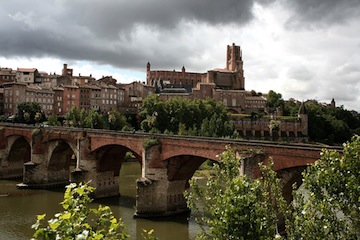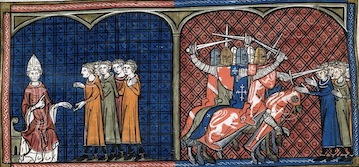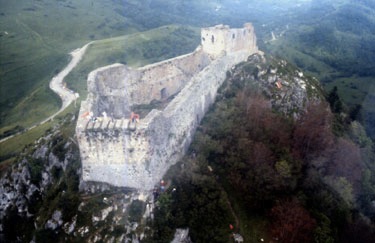Summary | Excerpt | Reviews | Beyond the Book | Read-Alikes | Genres & Themes | Author Bio

A Novel
by David MitchellThis article relates to The Bone Clocks
In the fight between the Atemporals and the Anchorites, The Bone Clocks frequently references the Cathars.
 The Cathars were members of a religious sect of Christianity that flourished in the 12th and 13th centuries in southern France and northern Italy. They believed in a dualistic theory of religion, with good and evil on opposing sides, and attributed all the wrongdoings in the Old Testament to the evil God. Believing the material world was bad, they believed in asceticism as a path to God. Since not everyone can follow the strict principles of asceticism, adherents to the Cathari way of life were divided into regular believers and a higher order of men and women who renounced all material goods but still performed basic services. The Cathars believed in reincarnation and didn't eat meat.
The Cathars were members of a religious sect of Christianity that flourished in the 12th and 13th centuries in southern France and northern Italy. They believed in a dualistic theory of religion, with good and evil on opposing sides, and attributed all the wrongdoings in the Old Testament to the evil God. Believing the material world was bad, they believed in asceticism as a path to God. Since not everyone can follow the strict principles of asceticism, adherents to the Cathari way of life were divided into regular believers and a higher order of men and women who renounced all material goods but still performed basic services. The Cathars believed in reincarnation and didn't eat meat.
The Cathar sect grew roots in the province of Languedoc in the south of France, which was already known for its culture of tolerance. As Cathari beliefs became increasingly implanted and spread in the twelfth and thirteenth centuries, their popularity became seen as a threat to the Catholic Church. The disdain felt by both groups was mutual. Believers in asceticism, the Catharis frowned upon the Catholic church's adoption of elaborate rituals complemented by bejewelled finery.
 The Catholic Church believed the town of Albi in southern France to be the Cathari stronghold. This lead to the Cathars being labeled the Albigenses. Calling the rise of the Cathars a heresy, Pope Innocent III decided enough was enough and launched a systematic attack against them. The kings of France took up this cause in later years and the prolonged fight, which killed thousands of Cathars and Catholics, came to be known as the Albigensian Crusade (1209-1229).
The Catholic Church believed the town of Albi in southern France to be the Cathari stronghold. This lead to the Cathars being labeled the Albigenses. Calling the rise of the Cathars a heresy, Pope Innocent III decided enough was enough and launched a systematic attack against them. The kings of France took up this cause in later years and the prolonged fight, which killed thousands of Cathars and Catholics, came to be known as the Albigensian Crusade (1209-1229).
 The Languedoc was decimated. In addition to the countless lives lost, in the mid-thirteenth century, a Cathari stronghold, the fortress of Château de Montségur near the Pyrenees, was destroyed. Many Cathars moved underground and some fled to Italy. The Cathars lingered through the 14th century and mostly disappeared early in the 15th. Even today vestiges of the sect, including the ruins of Château de Montségur, remain. The region still attracts tourism dollars with this history.
The Languedoc was decimated. In addition to the countless lives lost, in the mid-thirteenth century, a Cathari stronghold, the fortress of Château de Montségur near the Pyrenees, was destroyed. Many Cathars moved underground and some fled to Italy. The Cathars lingered through the 14th century and mostly disappeared early in the 15th. Even today vestiges of the sect, including the ruins of Château de Montségur, remain. The region still attracts tourism dollars with this history.
City of Albi, where the Cathars lived, courtesy of Marion Schneider & Christoph Aistleitner
Painting of Pope Innocent III excommunicating the Albigensians and massacre of Albigensians from the British Library
The current fortress where the castle of Montségur once stood, courtesy of Ceesharp
Filed under People, Eras & Events
![]() This "beyond the book article" relates to The Bone Clocks. It originally ran in September 2014 and has been updated for the
June 2015 paperback edition.
Go to magazine.
This "beyond the book article" relates to The Bone Clocks. It originally ran in September 2014 and has been updated for the
June 2015 paperback edition.
Go to magazine.






Your guide toexceptional books
BookBrowse seeks out and recommends the best in contemporary fiction and nonfiction—books that not only engage and entertain but also deepen our understanding of ourselves and the world around us.